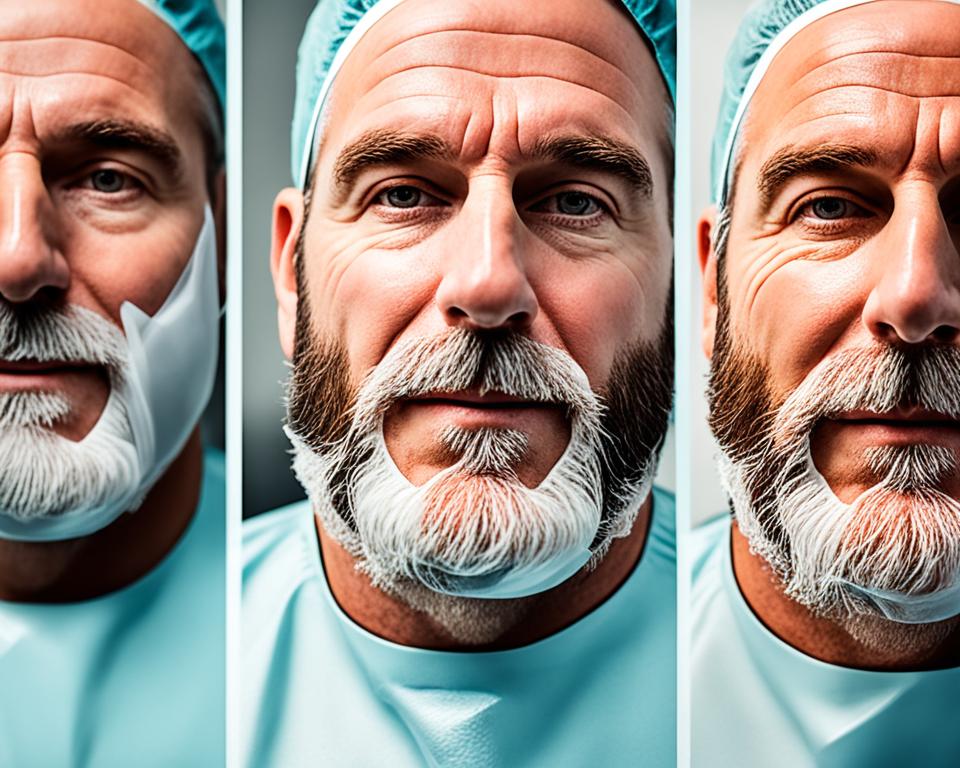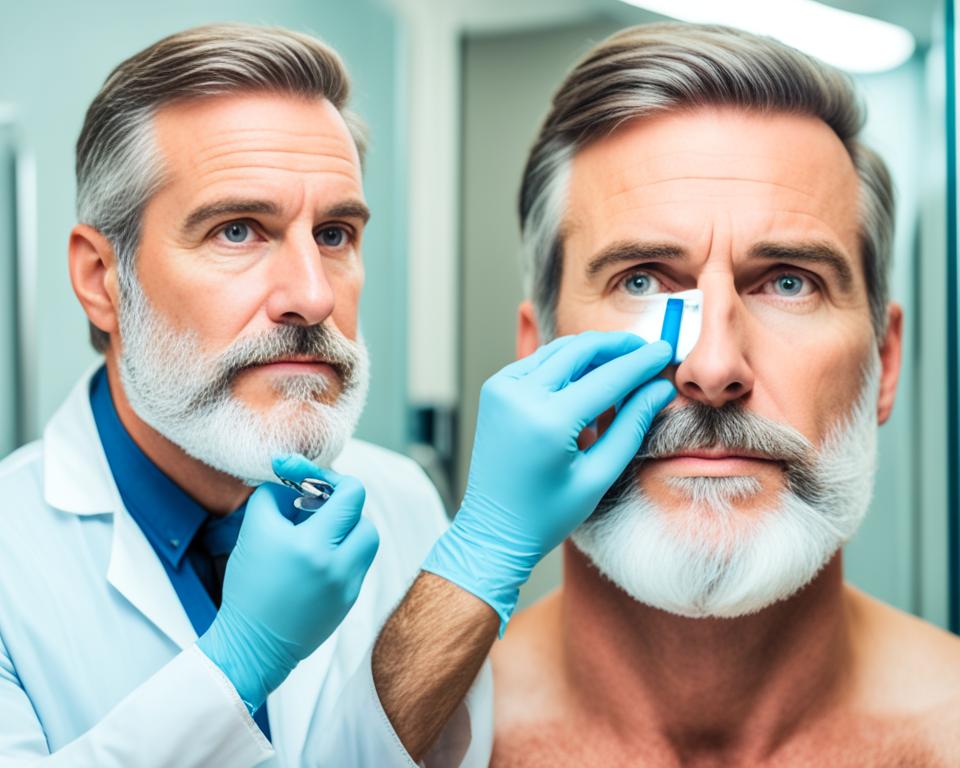Many men look for ways to make their facial hair thicker and more distinguished. Beard implants are a top choice for this. They are a type of hair transplant that makes your beard look more natural. This method is known as beard grafting or hair follicle extraction.
It’s becoming more popular for those wanting to look better and feel more confident.
Read interesting things at : kamilyle
Key Takeaways
- Beard implants are a hair transplant procedure that can help men achieve a fuller, more natural-looking beard.
- The procedure involves extracting hair follicles from the patient’s own body and implanting them into the desired areas of the face.
- Beard implants offer a long-lasting solution for those struggling with patchy or sparse facial hair.
- The consultation process is crucial to ensure the procedure aligns with the patient’s goals and expectations.
- Proper post-operative care is essential for optimal results and a smooth recovery.
What are Beard Implants?
Beard implants, also known as beard transplants, are a surgery that moves hair follicles from one body part to the face. This makes the beard fuller and more natural-looking. It’s a new way for men to improve their facial hair and get the beard they want.
Understanding the Procedure
There are two main ways to do beard implant surgery: Follicular Unit Extraction (FUE) and Direct Hair Implantation (DHI). Both take hair follicles from the scalp and put them on the face. This can be on the cheeks, chin, and neck.
Benefits of Beard Implants
- Improved self-confidence and self-esteem
- A more defined and masculine facial appearance
- The ability to grow a fuller, thicker beard
- Reduced patchy or uneven facial hair growth
- Long-lasting results with proper care and maintenance
Beard implants help men with thin or uneven facial hair. They can get the beard they’ve always wanted. This boosts their look and confidence.
Candidates for Beard Implant Surgery
Beard implants can help those with sparse, patchy, or uneven facial hair. These procedures fix the root cause, giving men the full, natural beard they want.
People with thin or uneven beards due to genetics or hair loss are good candidates. Those who have lost hair because of illness, injury, or past transplants can also benefit. If you want a fuller beard and know what to expect, you might be a good fit.
| Ideal Candidates | Disqualifying Factors |
|---|---|
|
|
Not everyone is a good match for beard implants. You might not be a candidate if you have high hopes that aren’t realistic, health issues, not enough donor hair, or poor skin quality in your face. Talking to an experienced surgeon is key to see if beard implants are right for you.
The Consultation Process
Before starting a beard implant procedure, patients meet with their surgeon for a detailed consultation. This meeting is key for clear communication, setting realistic goals, and finding the best way to get the look they want.
Discussing Your Goals
The surgeon will listen carefully to what the patient wants. They’ll talk about the look of the beard, how thick it should be, and what the final look should be like. This way, the treatment plan can match what the patient hopes for.
Evaluating Your Facial Hair
- The surgeon will look closely at the patient’s current facial hair growth patterns and how thick it is.
- This check-up helps spot areas where hair is thin or not even, which might need a beard implant procedure.
- The surgeon will also check the quality and health of the patient’s facial hair. This info helps decide on the best surgical steps and what results to expect.
By sharing the patient’s goals and doing a full facial hair evaluation, the surgeon can make a plan just for the patient. This plan will meet the patient’s specific needs and give the best beard implant results.
Preparing for the Procedure
Before getting a beard implant or beard transplant surgery, it’s important to prepare well. This ensures a safe and successful outcome. Let’s look at the key steps to get ready for this big change.
Discontinuing Certain Medications
You might need to stop taking some medicines, like blood thinners or anti-inflammatory drugs, weeks before the beard implant surgery. This helps avoid complications and aids healing. Always listen to what your surgeon says about your medicines.
Avoiding Smoking and Alcohol
Smoking and drinking too much can slow down healing and raise risks. You’re usually told to stop these habits before and after the beard transplant surgery.
Maintaining Good Oral Hygiene
Keeping your mouth clean is key before surgery. Make sure your teeth and gums are healthy. Any dental problems could affect the beard implant or recovery.
Following the Surgeon’s Instructions
It’s crucial to follow the surgeon’s pre-op advice. This includes what to eat, how to care for your hair, and other steps to make sure the beard implant goes smoothly.
“Proper pre-operative preparation is the foundation for a smooth and successful beard implant procedure.”
By sticking to these tips and working with your surgeon, you can have a great beard implant experience. You’ll be excited for the new look this procedure can give you.
The Beard Implant Surgery
Beard implant surgery, also known as hair transplant surgery, is a top choice for those wanting to boost their facial hair. It uses Follicular Unit Extraction (FUE) and Direct Hair Implantation (DHI) as main techniques.
Follicular Unit Extraction (FUE)
The FUE method takes hair follicles from the back and sides of the scalp. These follicles are then placed in the face where you want more beard. It’s a less invasive method that causes little scarring, making it a favorite among patients.
Direct Hair Implantation (DHI)
Direct Hair Implantation, or DHI, makes beard implanting quicker and easier. It doesn’t remove hair follicles first. Instead, a special tool puts them directly into the area. This can lead to quicker healing and a beard that looks very natural.
Both beard implants and hair transplant surgery methods, like FUE or DHI, help patients get the facial hair they want. The best method depends on what the patient needs, likes, and the surgeon’s skills.
“Beard implants have completely transformed my appearance and boosted my confidence. The results are natural-looking, and I couldn’t be happier with my decision to undergo the procedure.” – John Doe, Satisfied Beard Implant Patient
Recovering from Beard Implants
Getting beard implants is a big step towards a fuller, more natural look. But, how you recover is key to getting the best results. We’ll cover what you need to do after surgery and what side effects you might see during recovery.
Post-Operative Care
Your surgeon will give you detailed instructions on how to care for yourself after the surgery. This includes:
- Keeping the treated area clean and gently cleansing it as directed
- Applying any prescribed ointments or medications to the implant site
- Avoiding strenuous physical activity or excessive sweating for a specified period
- Attending follow-up appointments to monitor the healing progress
Following these steps is crucial to avoid complications and get the best results from your beard implants.
Potential Side Effects
Most people have a smooth recovery after beard implants. But, some might see temporary side effects, like:
- Swelling and redness around the implant site
- Temporary loss of some transplanted hair during the initial shedding phase
- Itching or mild discomfort as the implanted hair begins to grow
- Possible infection, which can be managed with proper care and medication
Your surgeon will help you manage these side effects of beard transplant. With careful post-operative care, most people recover fully and love their new look.

Beard Implants Results
Understanding what to expect from beard implants is key. Results can differ a lot from person to person. This depends on skin type, hair texture, and how your body heals. Knowing the timeline and expected hair growth is important.
Achieving Natural-Looking Results
Beard implants aim to give you a natural beard by moving hair follicles from the back of the head or chest to your face. This hair will grow and mix well with your existing facial hair, making your beard fuller and more dense.
But, the final look might not be exactly what you hoped for. The amount of hair growth and how full your beard gets can vary. Some people might see hair grow more slowly or not as evenly. It’s key to have realistic hopes and talk with your surgeon about what you might get.
Timeline for Seeing Results
How long it takes to see the full results of a beard implant varies. Usually, it takes a few months for the transplanted hair to fully grow and look natural. Right after surgery, you might lose some hair or see it thin out, which is normal.
After 3-6 months, the hair will start to grow back, and you’ll see your final results. By the 12-month mark, you should have the full, natural-looking beard you wanted.
Remember, beard implant results aren’t immediate. Being patient is crucial. With realistic expectations and help from an experienced surgeon, you can get the natural-looking beard you’ve dreamed of.
Maintaining Your New Beard
After getting a beard implant, taking good care of it is key for long-term success. How you treat your new hair affects how it looks and lasts. It’s important to pay attention to your facial hair.
To keep your beard looking great, here are some tips:
- Gentle Washing: Clean your beard with a mild, sulfate-free shampoo. Don’t scrub hard, as it can harm the new hair.
- Careful Styling: Use a soft brush or comb to style your beard. Don’t use too many styling products, as they can block pores and slow growth.
- Regular Trimming: Trim your beard often to keep it neat. Use sharp scissors or trimmers to avoid split ends and uneven growth.
- Moisturize and Condition: Use a beard oil or balm to keep your hair and skin moisturized and healthy.
By following these beard maintenance tips, your new hair will do well. Your beard will stay a symbol of pride and confidence.
“Caring for your beard after a transplant is essential to achieving the best possible results.”
Being consistent is crucial when looking after caring for transplanted hair. Adding these beard maintenance habits to your daily routine will help you have a healthy, vibrant, and lasting beard.
Beard Implants Costs and Financing
When looking into beard implants cost, it’s key to know what affects the price. The cost includes the surgeon’s fees, the place where you get the procedure, and costs for aftercare. Prices can change based on where you live, the complexity of your case, and the surgeon’s skills. It’s good to understand the money you might need to spend.
Thinking about beard transplant financing means looking at payment plans or medical financing. Many good clinics and surgeons offer flexible ways to pay. These can be low-interest payment plans, healthcare credit cards, or financing partnerships that spread the cost over time.
- The average cost of beard implants is between $3,000 and $15,000. This depends on how complex the procedure is and the surgeon’s skills.
- Financing options, like payment plans or medical credit cards, can make the procedure more affordable. They let you pay in smaller amounts over time.
- It’s important to look into the costs and financing options in your area. This way, you can find the best option that fits your budget and what you want.
Deciding on beard implant surgery means thinking about the money side of it. By understanding the usual costs and the financing options, you can make a choice that fits your goals and budget.

“Investing in a natural-looking, full beard can be life-changing for many individuals who struggle with patchy or sparse facial hair. The availability of financing options makes this transformative procedure more accessible than ever before.”
Choosing the Right Surgeon
Choosing the right surgeon for beard implants is key to getting the results you want. The surgeon’s skills and experience greatly affect the success of the procedure. It’s important to research and check out potential surgeons to make sure you’re making a good choice.
Credentials and Experience
Start by looking at the surgeon’s credentials and experience. Make sure they are board-certified in plastic surgery or dermatology, with a focus on facial hair restoration. This shows they have the right training and know-how.
Also, find out how much experience they have with beard implants. Ask about their success rate and the methods they use. A surgeon with a good track record and deep knowledge of beard implants is more likely to give you the results you want.
| Credential | Importance |
|---|---|
| Board Certification in Plastic Surgery or Dermatology | Ensures the surgeon has undergone rigorous training and is qualified to perform complex facial procedures. |
| Specialization in Facial Hair Restoration | Demonstrates the surgeon’s specific expertise in beard implant and facial hair transplant techniques. |
| Extensive Experience in Beard Implant Procedures | A surgeon with a proven track record of successful beard implant surgeries is more likely to deliver the desired results. |
By looking at a surgeon’s credentials and experience, you can be sure you’re choosing a skilled and trustworthy professional. They will help you get the full, natural-looking beard you want.
Alternative Options to Beard Implants
Beard implants are a great way to boost facial hair, but there are other options too. These alternatives offer different ways to meet your needs and preferences.
Beard Growth Supplements
Beard growth supplements are packed with vitamins, minerals, and natural stuff. They help your facial hair grow by feeding the follicles and making your beard healthy.
Minoxidil Treatments
Minoxidil is a special solution you put on your skin. It’s approved by the FDA and helps grow new hair and make existing hair thicker.
Non-Surgical Techniques
- Microblading uses fine needles to make your facial hair look fuller. It’s a semi-permanent way to get a fuller beard.
- Temporary Hair Fibers make your facial hair look thicker right away. You don’t need surgery for this.
These options give you many ways to improve your facial hair. You can choose from supplements, treatments, or non-surgical methods. There are alternatives to beard implants that can help with facial hair restoration options.
| Alternative Option | Description | Advantages | Disadvantages |
|---|---|---|---|
| Beard Growth Supplements | Supplements with vitamins and natural stuff for facial hair growth |
|
|
| Minoxidil Treatments | Special solution for your skin to grow facial hair |
|
|
| Microblading | Makeup technique to look like you have more facial hair |
|
|
| Temporary Hair Fibers | Fibers you put on your skin to look like you have more hair |
|
|
“While beard implants are a permanent fix, other options give you ways to improve your facial hair without surgery.”
Conclusion
Beard implants are changing the game for men wanting to improve their facial hair naturally. This method brings many benefits, like a fuller, more even, and lasting beard. By moving hair follicles from other body parts, skilled doctors can give you the look you want and boost your confidence.
If you’re dealing with patchy or thinning hair, or just want a better look, beard implants could be what you need. But, it’s key to talk to a skilled and experienced surgeon. They can look at your needs and make a plan just for you. With the right help, you can see big changes from beard implants and start a new chapter in facial hair care.
When looking into beard implants, always put your safety first. Do your homework and pick a trusted provider to help you. With the right steps, beard implants can open up a new, more confident you. They let you show off your unique style and how you express yourself.


